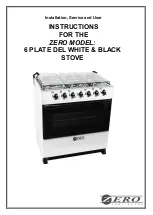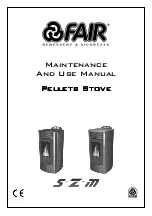
14
the heater will operate on the highest setting, we recommend to operate your heater on this setting for only a
short period of time. (1 hour etc.) Your pellet stove also includes an auto-start igniter as a standard feature. The
use of other fire starter materials (wood chips, starter gel, etc.) is not necessary. By simply pressing the “ON” button
on the digital control panel, your stove will begin to feed fuel and automatically start within 5 minutes.
TAMPER WARNING
This wood heater has a manufacturer-set minimum low burn rate that must not be altered. It is against federal
regulations to alter this setting or otherwise operate this wood heater in a manner inconsistent with operating
instructions in this manual.
• Failure to clean and maintain this unit as indicated can result in poor performance and safety hazards.
•
Unplug your stove’s electrical cord prior to removing the back panel or opening the exhaust system for any
inspection, cleaning, or maintenance work.
• Never perform any inspections, cleaning, or maintenance on a hot stove.
•
Do not operate stove with broken glass , leakage of flue gas may result.
•
WARNING THE CHIMNEY AND CHIMNEY CONNECTOR MUST BE KEPT IN GOOD CONDITION AND CLEAN.
EXHAUST SYSTEM
Creosote Formation – When any wood is burned slowly, it produces tar and other organic vapors, which combine
with expelled moisture to form creosote. The creosote vapors condense in the relatively cool chimney flue or a
newly started fire or from a slow-burning fire. As a result, creosote residue accumulates on the flue lining. When
ignited, this creosote makes an extremely hot fire, which may damage the chimney or even destroy the house.
Despite their high efficiency, pellet stoves can accumulate creosote under certain conditions.
Fly Ash – This accumulates in the horizontal portion of an exhaust run. Though non-combustible, it may impede
the normal exhaust flow. It should therefore be periodically removed.
Inspection and Removal – The chimney connector and chimney should be inspected annually or per ton to
determine if a creosote or fly ash build-up has occurred. If creosote has accumulated, it should be removed to
reduce the risk of a chimney fire. Inspect the system at the stove connection and at the chimney top. Cooler
surfaces tend to build creosote deposits quicker, so it is important to check the chimney from the top as well as
from the bottom. The creosote should be removed with a brush specifically designed for the type of chimney
in use. A qualified chimney sweep can perform this service. It is also recommended that before each heating
season the entire system be professionally inspected, cleaned and, if necessary, repaired. To clean the chimney,
disconnect the vent from the stove.
INTERIOR CHAMBERS
Periodically remove and clean the burnpot and the area inside the burnpot housing. In particular it is advisable
to clean out the holes in the burnpot to remove any build up that may prevent air from moving through the burn
pot freely. Remove the two (2) plates on each side of the burnpot housing and clean out that rear chamber.
After Ash removal re-secure the two (2) plates on each side of the burnpot.
If a vacuum is used to clean your stove, we suggest using a vacuum designed for ash removal. Some regular
vacuum cleaner (i.e. shop vacs) may leak ash into the room.
ASH DISPOSAL
Ashes should be placed in a metal container with a tight fitting lid. The closed container of ashes should moved
outdoors immediately, well away from all combustible materials, pending final disposal. If the ashes are disposed
of by burial in soil or otherwise locally dispersed, they should be retained in the closed container until all cinders
have been thoroughly cooled. The container shall not be used for other trash or waste disposal.
SMOKE AND CO MONITORS
Burning wood naturally produces smoke and carbon monoxide(CO) emissions. CO is a poisonous gas when
exposed to elevated concentrations for extended periods of time. While the modern combustion systems in
heaters drastically reduce the amount of CO emitted out the chimney, exposure to the gases in closed or confined
areas can be dangerous. Make sure you stove gaskets and chimney joints are in good working order and sealing
properly to ensure unintended exposure. It is recommended that you use both smoke and CO monitors in areas
having the potential to generate CO.
CHECK AND CLEAN THE HOPPER
Check the hopper periodically to determine if there is any sawdust or pellets that are sticking to the hopper
surface. Clean as needed.
Maintenance
Summary of Contents for King
Page 19: ...19 Parts Diagram...
Page 22: ...22 Notes...
Page 23: ...23 Notes...
Page 24: ...24 Notes...
Page 30: ...19 Sch ma des pi ces...















































